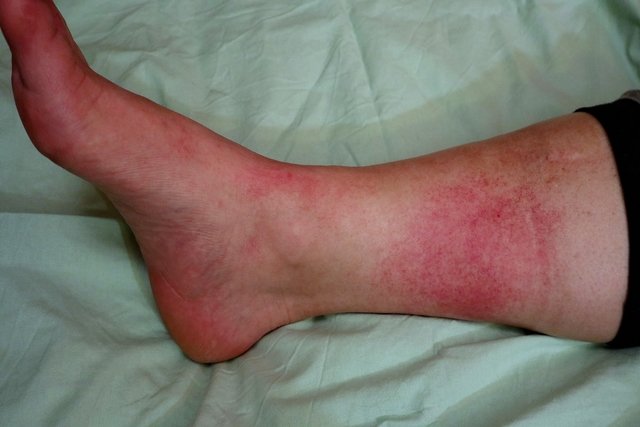Erysipelas is an infection of the upper layer of the skin caused by bacteria Group A Beta-hemolytic Streptococcuswhich penetrates the skin through wounds or lesions, resulting in symptoms such as fever, chills, redness of the skin or even blisters.
This infection can appear in the legs and is more common in people with venous insufficiency, obesity or decompensated diabetes, but it can also affect the arms or even the face due to recent throat infections.
The treatment of erysipelas is carried out by a dermatologist or clinician and involves the use of oral antibiotics to combat the infection, and in more serious cases, hospitalization for the use of intravenous antibiotics.
Sensitive content
This image may contain content that is uncomfortable for some people.

Erysipelas symptoms
The main symptoms of erysipelas are:
- Bright red plaques on the skin, with well-defined and raised edges;
- Swelling of the skin;
- Burning sensation in the lesion;
- Sensitivity and itching at the site;
- Increase in local temperature;
- Malaise, fever and chills, generally 48 hours before the skin lesions appear.
In more serious cases, darkening of the skin and formation of blisters may occur, in which case it is called bullous erysipelas. See other symptoms of bullous erysipelas.
It is important to consult a dermatologist as soon as possible when symptoms of erysipelas appear, so that the diagnosis can be made and the most appropriate treatment can be initiated.
If you experience symptoms of erysipelas, make an appointment with a dermatologist in the nearest region:
Taking care of your health has never been easier!
What is the difference between erysipelas and cellulitis?
Both erysipelas and cellulitis are bacterial skin infections. However, erysipelas affects more superficial layers of the skin, while cellulite affects deeper layers and fatty tissue.
Furthermore, there are also differences in the appearance of the skin lesion, as in erysipelas the wound is bright red and has well-defined edges. In cellulite, the lesions are pinker and more diffuse, meaning they do not have well-defined edges. Understand better what cellulite is.
How to confirm the diagnosis
The diagnosis of bullous erysipelas is clinical and is made by a dermatologist or general practitioner, through the assessment of symptoms, characteristics of the skin lesion and health history.
However, blood tests such as blood count, ESR and C-reactive protein or blood culture may be requested, in order to identify which bacteria is causing the infection, and thus indicate the best antibiotic, for example.
In cases where blisters form on the skin, the doctor may request a culture test of the liquid contained in the blisters, to assess the presence of bacteria and their type.
Possible causes
Erysipelas is caused by an infection with bacteria Group A beta-hemolytic Streptococcuswhich penetrates the skin through small lesions or wounds, such as insect bites, scratches, bites, chilblains on the feet or nail fungus, for example.
Some factors can contribute to the development of erysipelas, such as:
- Chronic venous insufficiency;
- Surgery to remove the saphenous vein;
- Obstruction of lymphatic vessels;
- Decompensated diabetes;
- Obesity or overweight;
- Arteriovenous fistula;
- Nephrotic syndrome;
- Mastectomy surgery.
Additionally, people with weakened immune systems also have an increased risk of developing erysipelas.
In the case of facial erysipelas, the most common cause is recent throat infections, caused by the bacteria Group A beta-hemolytic Streptococcus, also known as Streptcoccus pyogenes.
How the treatment is carried out
The treatment of bullous erysipelas must be carried out under the guidance of a dermatologist or general practitioner and involves the use of oral antibiotics, with the first choice generally being penicillins or cephalosporins, for 5 to 10 days.
Furthermore, to complement the treatment, the doctor may recommend rest, elevating the legs, drinking plenty of water, applying cold compresses to the area and taking painkillers, such as paracetamol, to reduce the fever. Check out all the treatment options for erysipelas.
In some cases, especially in people with a weakened immune system, skin necrosis, children or the elderly, hospital admission and intravenous antibiotics may be necessary.
Is erysipelas curable?
Erysipelas can be cured as long as the treatment is carried out correctly with the guidance of a dermatologist or general practitioner, and started as soon as possible as soon as symptoms appear.
In this way, it is possible to cure erysipelas and avoid possible complications and reinfection.
Possible complications
Erysipelas can cause serious complications, such as abscess at the site of the injury, pneumonia, scarlet fever, meningitis, skin necrosis, thrombophlebitis or hemorrhagic purpura.
Furthermore, another complication is bullous erysipelas, which is a more serious type of erysipelas that affects deeper layers of the skin.

Sign up for our newsletter and stay up to date with exclusive news
that can transform your routine!
Warning: Undefined array key "title" in /home/storelat/public_html/wp-content/plugins/link-whisper-premium/templates/frontend/related-posts.php on line 12
Warning: Undefined array key "title_tag" in /home/storelat/public_html/wp-content/plugins/link-whisper-premium/templates/frontend/related-posts.php on line 13




